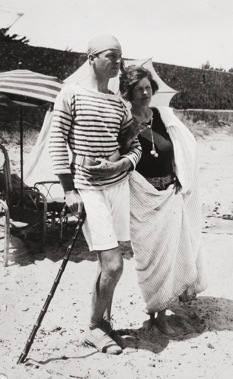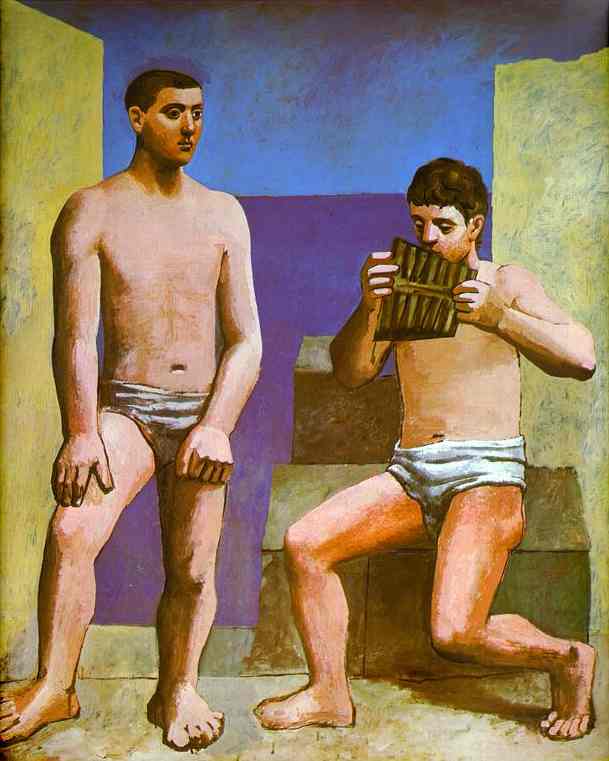Two of the most interesting people of the first half of the 20th century were Gerald and Sarah MUrphy. They were rich expatriates but were far more. They were friends with everyone who mattered in the arts in the 1920s.
Gerald liked costumes and was completely unaffected by convention.
Gerald Clery Murphy and Sara Sherman Wiborg were wealthy, expatriate Americans who moved to the French Riviera in the early 20th century and who, with their generous hospitality and flair for parties, created a vibrant social circle, particularly in the 1920s, that included a great number of artists and writers of the Lost Generation. Gerald had a brief but significant career as a painter.
Gerald Clery Murphy (March 25, 1888 – October 17, 1964) born in Boston to the family that owned the Mark Cross Company, sellers of fine leather goods. His father had, in fact, suggested that the fine saddler, Mark Cross, enter the field of leather goods, other than saddlery. The business moved to New York and thrived. His father actually began as a saddle maker but managed to transition to the automobile era by becoming a maker of fine leather goods. The company, partly as a result of Gerald’s later efforts, remains successful 100 years later.
Gerald was an esthete from his childhood forward. He was never comfortable in the boardrooms and clubs for which his father was grooming him. He flunked the entrance exams at Yale three times before matriculating, although he performed respectably there. He joined DKE and the Skull and Bones society. He befriended a young freshman named Cole Porter (Yale class of 1913) and brought him into DKE. Murphy also introduced Porter to his friends, propelling him into writing music for Yale musicals.
His friendship with Cole Porter had a tremendous, not always positive, effect on his life.
Sara Sherman Wiborg (November 7, 1883 – October 10, 1975) was born in Cincinnati, Ohio, into the wealthy Wiborg family. Her father, manufacturing chemist and owner of his own printing ink and varnish company. Such ink product were highly important in the printing world of lithographs and Frank Bestow Wiborg, was a self-made millionaire by the age of 40. Sara’s mother was a member of the noted Sherman family, daughter of Hoyt Sherman, and niece to Civil War General William Tecumseh Sherman. Raised in Cincinnati, her family moved to Germany for several years when she was a teenager, so her father could concentrate on the European expansion of his company. The Wiborg family was easily accepted into the high society community of 20th century Europe. While in Europe, Sara and her sisters Hoytie and Olga sang together at high-class assemblies and were presented to the kaiser. Upon returning to the United States, the Wiborgs spent most of their time in New York City and, later, East Hampton, where they were one of the first wealthy families to build a home, on 600 acres.
The Wiborg fortune was based on the invention by her father of solid inks. These were widely used in printing.
Sarah and her sisters spent years in Europe prior to World War I and were the first family, certainly the first American family, to tour Europe by car. In spite of numerous breakdowns, they managed to travel across France and part of Spain in 1914.
In East Hampton Sara Wiborg and Gerald Murphy met when they were both adolescents. Gerald was five years younger than Sara, and for many years they were more familiar companions than romantically attached; they became engaged in 1915, when Sara was 32 years old. Sara’s parents did not approve of their daughter marrying someone “in trade,” and Gerald’s parents were not much happier with the prospect, seemingly because his father found it difficult to approve anything that Gerald did.
After marrying they lived at 50 West 11th Street in New York City, where they had three children. In 1921 they moved to Paris to escape the strictures of New York and their families’ mutual dissatisfaction with their marriage. In Paris Gerald took up painting, and they began to make the acquaintances for which they became famous.
Eventually they moved to the French Riviera, where they became the center of a large circle of artists and writers of later fame, especially Zelda and F. Scott Fitzgerald, Ernest Hemingway, John Dos Passos, Fernand Léger, Jean Cocteau, Pablo Picasso, Archibald MacLeish, John O’Hara, Cole Porter, Dorothy Parker and Robert Benchley.
The French Riviera was a favorite winter vacation spot for the English who determined what was fashionable at the time. In 1923, the Murphys convinced the proprietors of the Hotel du Cap to stay open for the summer so that they might entertain their friends, sparking a new era for the French Riviera as a summer haven. They purchased a villa and refurbished it, calling it the “Villa Americain.”
When the Murphys arrived on the Riviera, lying on the beach merely to enjoy the sun was not a common activity. Occasionally, someone would go swimming, but the joys of being at the beach just for sun were still unknown at the time. The Murphys, with their long forays and picnics at La Garoupe, introduced sunbathing on the beach as a fashionable activity.
They were accompanied by friends, including Pablo Picasso who seems to have had an unrequited passion for Sara. He painted her as a nude, although it is doubtful he ever saw her so. She was well known for wearing her large string of pearls, even at the beach.
His paintings include one, named “Pipes of Pan”, which includes a painted over image thought to be Sara.
A contemporary portrait of Sara suggests her beauty.
There are her pearls.
This will be continued.


